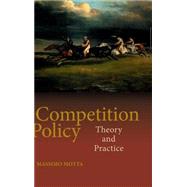
Competition Policy: Theory and Practice
by Massimo Motta-

This Item Qualifies for Free Shipping!*
*Excludes marketplace orders.
Buy New
Rent Textbook
Rent Digital
Used Textbook
We're Sorry
Sold Out
How Marketplace Works:
- This item is offered by an independent seller and not shipped from our warehouse
- Item details like edition and cover design may differ from our description; see seller's comments before ordering.
- Sellers much confirm and ship within two business days; otherwise, the order will be cancelled and refunded.
- Marketplace purchases cannot be returned to eCampus.com. Contact the seller directly for inquiries; if no response within two days, contact customer service.
- Additional shipping costs apply to Marketplace purchases. Review shipping costs at checkout.
Summary
Table of Contents
| Part I. Competition Policy: History, Objectives and the Law: 1.1 Introduction | |
| 1.2 Brief history of competition policy | |
| 1.3 Objectives of competition policy, and other public policies | |
| 1.4 The main features of European competition law | |
| 1.5 Exercises | |
| Part II. Market Power and Welfare: Introduction: 2.1 Overview of the chapter | |
| 2.2 Allocative efficiency | |
| 2.3 Productive efficiency | |
| 2.4 Dynamic efficiency | |
| 2.5 Public policies and incentives to innovate | |
| 2.6 Monopoly: will the market fix it all? | |
| 2.7 Summary and policy conclusions | |
| 2.8 Exercises | |
| 2.9 Solutions of exercises | |
| Part III. Market Definition and the Assessment of Market Power: 3.1 Introduction | |
| 3.2 Market definition | |
| 3.3 The assessment of market power | |
| 3.4 Exercises | |
| Part IV. Collusion and Horizontal Agreements: 4.1 Introduction | |
| 4.2 Factors that facilitate collusion | |
| 4.3 Advanced material | |
| 4.4 Practice: what should be legal and what illegal? | |
| 4.5 Joint-ventures and other horizontal agreements | |
| 4.6 A case of parallel behaviour: wood pulp | |
| 4.7 Exercises | |
| Part V. Horizontal Mergers: 5.1 Introduction, 5.2 Unilateral effects | |
| 5.3 Pro-collusive effects | |
| 5.4 A more general model | |
| 5.5 Merger remedies | |
| 5.6 Merger policy in the European Union | |
| 5.7 Case studies | |
| 5.8 Exercises | |
| Part VI. Vertical Restraints and Vertical Mergers: 6.1 What are vertical restraints? | |
| 6.2 Intra-brand competition | |
| 6.3 Inter-brand competition | |
| 6.4 Anti-competitive effects: leverage and foreclosure | |
| 6.5 Conclusions and policy implications | |
| 6.6 Cases | |
| 6.7 Exercises | |
| Part VII. Predation, Monopolisation, and Other Abusive Practices: 7.1 Introduction | |
| 7.2 Predatory pricing | |
| 7.3 Non-price monopolisation practices | |
| 7.4 Price discrimination | |
| 7.5 US v. Microsoft | |
| 7.6 Exercises | |
| 7.7 Solutions of exercises | |
| Part VIII. A Toolkit: Game Theory and Imperfect Competition Models: 8.1 Introduction | |
| 8.2 Monopoly | |
| 8.3 Oligopoly I: market competition in static games | |
| 8.4 Oligopoly II: dynamic games | |
| 8.5 Appendix. |
An electronic version of this book is available through VitalSource.
This book is viewable on PC, Mac, iPhone, iPad, iPod Touch, and most smartphones.
By purchasing, you will be able to view this book online, as well as download it, for the chosen number of days.
Digital License
You are licensing a digital product for a set duration. Durations are set forth in the product description, with "Lifetime" typically meaning five (5) years of online access and permanent download to a supported device. All licenses are non-transferable.
More details can be found here.
A downloadable version of this book is available through the eCampus Reader or compatible Adobe readers.
Applications are available on iOS, Android, PC, Mac, and Windows Mobile platforms.
Please view the compatibility matrix prior to purchase.